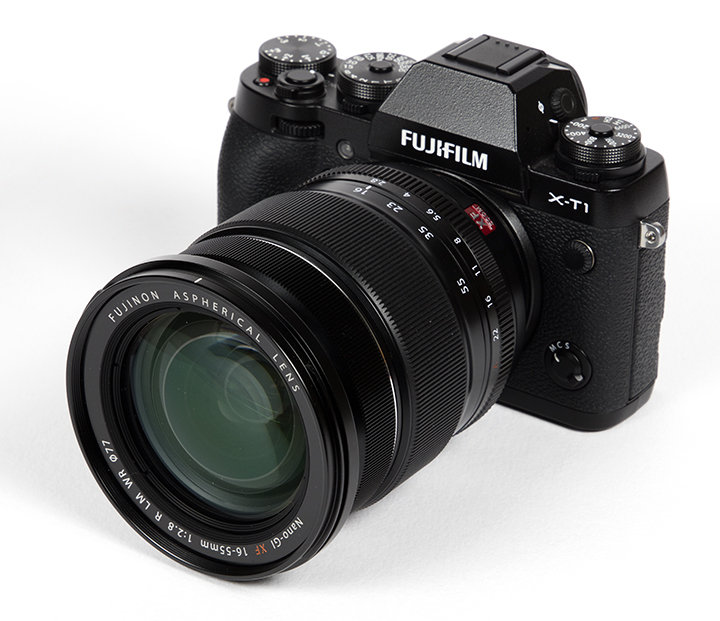|
Fujinon XF 16-55mm f/2.8 R LM WR ( Fujifilm ) Review / Test |
|
Lens Reviews -
Fujifilm X
|
|
Page 1 of 3
 Review by Klaus Schroiff, published February 2016
Review by Klaus Schroiff, published February 2016
Introduction
One of the core elements of a professional lens system is a fast standard zoom lens. Fujifilm is targeting the higher end of the
market so it's no surprise that they came up with their interpretation of the topic - the Fujinon XF 16-55mm f/2.8 R LM WR.
Some of you may hate the equivalence game by now but still ... this is equivalent to "24-84mm f/4.2" on full format cameras.
As such it is a pretty attractive all-round lens which covers everything from moderate wide-angle to moderate tele views.
Fast standard zoom lenses are never cheap in the first place and Fujifilm likes to stay away from budget offerings so if you feel
the itch be prepared to pay ... a lot - currently about 1000EUR/1200US$.
 Upon unboxing one aspect is immediately obvious ... it is BIG - by mirrorless standards anyway.
In fact it is about as as big & heavy as the Canon EF-S 17-55mm f/2.8 USM IS or the Nikkor AF-S 17-55mm f/2.8 ED
and these are DSLR lenses. Again, no surprise here - Fujifilm prefers "substance" over miniaturization.
At least in theory this is a good thing regarding the potential performance.
All lens elements have a HT-EBC (High Transmittance Electron Beam Coating) as well as Fujifilm's new Nano-GI
(Gradient-Index) coating for superior flare control and we can confirm that this seems to be more efficient than usual.
The weather sealing does not only shield against dust and humidity, the lens is also specified to operate down to -10C.
The build quality is very good although it is, again, worth to mention that the XF 16-55mm f/2.8 R LM WR
suffers from rattling when shaking the lens - probably from the rather loose auto-focus group. This annoyance is gone
once you power on the camera though. The broad rubberized controls operate very smoothly.
The Fujinon has a mono-cam system so it extends when zooming out to 55mm.
A petal-shaped lens hood is also part of the package.
Upon unboxing one aspect is immediately obvious ... it is BIG - by mirrorless standards anyway.
In fact it is about as as big & heavy as the Canon EF-S 17-55mm f/2.8 USM IS or the Nikkor AF-S 17-55mm f/2.8 ED
and these are DSLR lenses. Again, no surprise here - Fujifilm prefers "substance" over miniaturization.
At least in theory this is a good thing regarding the potential performance.
All lens elements have a HT-EBC (High Transmittance Electron Beam Coating) as well as Fujifilm's new Nano-GI
(Gradient-Index) coating for superior flare control and we can confirm that this seems to be more efficient than usual.
The weather sealing does not only shield against dust and humidity, the lens is also specified to operate down to -10C.
The build quality is very good although it is, again, worth to mention that the XF 16-55mm f/2.8 R LM WR
suffers from rattling when shaking the lens - probably from the rather loose auto-focus group. This annoyance is gone
once you power on the camera though. The broad rubberized controls operate very smoothly.
The Fujinon has a mono-cam system so it extends when zooming out to 55mm.
A petal-shaped lens hood is also part of the package.
 The internal AF system uses a "Twin Linear Motor" which provides fast and silent AF operations.
As usual manual focusing works by wire thus by driving the AF motor.
The internal AF system uses a "Twin Linear Motor" which provides fast and silent AF operations.
As usual manual focusing works by wire thus by driving the AF motor.
Some users/readers may be annoyed by the fact that the lens doesn't feature an image stabilizer.
Honestly, I am not among them although this has always been a debate among the editors here at PZ. Image stabilizers are useful, no doubts there, but they introduce an inherently unstable lens group. Over time it'll deteriorate (comparatively more) so an IS comes at cost of long term image consistency. So yes, count me to the conservative horde here - I like pure players - but your mileage may vary, of course.
| Specifications |
|---|
| Equiv. focal length | "24-84mm" (full format equivalent) |
| Equiv. aperture | "f/4.2" (full format equivalent, in terms of depth-of-field) |
| Optical construction | 17 elements 12 groups inc. 3 aspherical and 3 extra low dispersion elements |
| Number of aperture blades | 9 (circular) |
| min. focus distance | 0.3-0.4m (max. magnification 1:6.25) |
| Dimensions | 83.3x106.0mm |
| Weight | 655g |
| Filter size | 77mm |
| Hood | petal-shaped, bayonet mount, supplied |
| Other features | weather-sealing, Nano-GI coating |
|